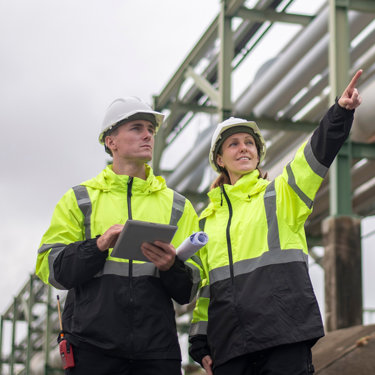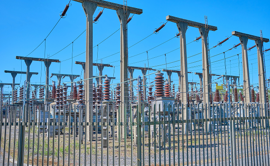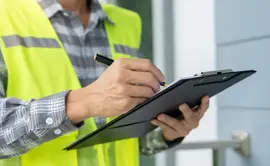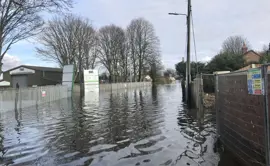The environmental considerations for decommissioning a forecourt and repurposing for development
Published: 5 July 2021
By: Bryan Cherry, Environmental Risk Survey Manager
As the demand for affordable property rises across the country, developers are looking to brownfield sites, such as decommissioned petrol filling stations, as a creative solution to the UK housing crisis. The transformation of filling stations to family homes or retirement communities can be a lucrative leap for both builders and site owners. However, the greatest risk for these developments is from what is in the ground, meaning the process presents considerable time, cost and environmental risks.
Bryan Cherry, Bsc (Hons), Environmental Risk Survey Manager, explains the complex journey from decommissioning to remediation and development – and how to ensure that the development goes ahead whilst reducing risk and cost.
Pinpointing potential contamination
Before any construction work can begin, operators must verify that the land in question is safe for its intended use and does not contain pollutants that could impact human health or the site’s surrounding environment. They must also prove that all environmental risks have been examined and that pre-emptive plans are in place to protect local residents, wildlife and water sources.
An efficient, effective, and environmentally responsible approach to decommissioning demands a wide-ranging team of experts – from geo-environmental specialists and DSEAR-qualified demolition engineers to skilled project managers who co-ordinate the entire operation. Partnering with an environmental risk specialist not only demonstrates duty of care from day one but also provides access to key services.
The majority of vacated and derelict forecourts present some measure of contamination sourced from leaking pipework, corroded fuel storage tanks or past surface-level spills. An expert’s initial aim is to accurately assess whether anything is there; how bad it is; and whether it is a problem. With that in mind, the decommissioning process generally begins behind the desk, with research into the ‘big picture’ view of soil and groundwater conditions and what contaminants are likely to be there. A detailed desk study involves historical map reviews, as well as liaison with the local authority and local petroleum licensing officers to flag potential contamination hazards (referred to as ‘sources’), what could be affected (a ‘receptor), and how these can be impacted by any contamination (‘pathway’). The combination of all three of these aspects (known as a ‘pollutant linkage’) enables an initial assessment of the environmental risks that may be present.
In the case of a former forecourt, the most likely scenario involves petrol, diesel and/or disused paraffin stores leaching through soil into nearby groundwater supplies, posing health hazards to neighbouring communities and the wider environment.
As well as toxic compounds within petroleum products, these early exploratory exercises highlight legacy pollutants from the property’s former uses – such as asbestos and heavy metals - left behind from decades of poor earthworks, construction and site management practices.
Digging deeper – soil sampling and quantitative risk analysis
Armed with a conceptual model of potential pollutant linkages, experts then progress to a technical site investigation. This process involves testing of the site for the presence of contamination on, in or under the ground through excavation and/or borehole drilling. Samples of soil and water (groundwater and from nearby water features if necessary) are collected during this process and tested to confirm the levels of contamination present.
An in-depth scientific report then outlines the scale and scope of contamination present at the site and allows an updated risk assessment (including mathematically modelled quantitative risk assessment if necessary).
While trusted technical expertise is key at this stage, the right partner will also actively support the commercial drivers of decommissioning work. It is at this stage when the full picture of the extent and severity of contamination is known, that the experts use this to design a strategy for remediating the site so that the scale of contamination can be reduced to a level suitable for its proposed end use.
Breaking ground – due diligence, degassing and demolition
With a remediation strategy now defined, the project now shifts to the demolition phase, making the site safe, clear, and accessible. Depending on the land’s intended use, ‘demolition’ work could range from infilling tanks and leaving them safely in situ (a cost-effective option for non-residential estates such as car parks and retail spaces) to full tank removal and disposal – the typical required approach for proposed housing developments.
The extraction of fuel tanks is a highly specialised, hazardous operation that requires both a technically trained team and a catalogue of legal preparation. A ‘one-stop-shop’ environmental specialist with access to full turnkey solutions will ensure third party contractors and in-house professionals hold appropriate qualifications and that necessary due diligence is carried out before the team breaks ground. Essential work at this stage runs from initiating updated risk assessments and health and safety provisions under the Construction, Design and Management (CDM) Regulations 2015, to the production of a point-by-point remediation method statement (RMS).
The method statement document details the plans, processes and protocols required to deliver the work alongside all possible environmental and health and safety considerations, from excessive noise to explosive atmospheres, and the control measures in place to prevent them. This document is submitted to regulatory authorities and planners for sign off before demolition begins. It also acts as a blueprint for internal teams and subcontractors to guarantee a co-ordinated course of action once work is under way.
Tank drainage and gas freeing are the first critical steps in rendering the site safe. After exposing the below ground infrastructure, expert fuel engineers carry out an environmentally sensitive process called ‘bottoming’, which includes dropping fuel valves to purge them of gas and liquid, cleaning tanks, lines, separators and dispensers, and removing residual materials for responsible waste disposal.
At this point in the tank removal process, the risk of leaks, fires and explosions from combustible gases is at its highest. As petrol can release flammable fumes even at very low temperatures, gas monitor wands are placed inside pipes to regulate vapour levels and ensure all activity complies with the Dangerous Substances and Explosive Atmospheres Regulations 2002 (DSEAR). CompEx electricians – trained to work in unstable environments – are then tasked with isolating the site, dealing with electrical distribution equipment and cutting through potentially volatile structures, ready for removal.
Environmental awareness at every stage - the decommissioning process
The dismantling of fuel networks and removal of hazardous liquids are pivotal points in the decommissioning operation. Because petrol will freely flow in excess of 400 metres, a spill at this risk-charged stage will endanger ecosystems well beyond the boundaries of the site – and place polluters open to criminal prosecution.
Under the Environmental Protection Act 1990, negligent operators must cover all containment, decontamination and compensation expenses following a pollution incident. Penalties often spiral into the tens of millions, and while liability can be transferred between parties – for example, the developer may buy the land at a reduced rate in exchange for covering clean-up costs – all stakeholders stand to face significant financial and reputational damage. In line with increasingly stricter sentencing laws, courts can now find individual company owners and executives personally responsible for serious ecological events. Aligning with an expert in spill prevention, environmental regulations and emergency response not only cuts the risk of severe harm but also of heavy fines, negative press, and crippling operational downtime.
Enabling development - remediation, monitoring and measurement
Once the site has been decommissioned and made safe then remediation work to reduce contamination levels can commence. This may involve large scale excavation but, due to cost and sustainability reasons, the industry has moved away from this method and now focusses on a variety of treatment methods by either biological or chemical means. These allow the treatment of the contamination whilst it is still in the ground (known as ‘in -situ’ remediation) or on the surface of the site.
To demonstrate environmental best practice, an ongoing programme of soil and groundwater monitoring is introduced to check for signs of subsurface pollution. Validation continues through the entire remediation process, and for a period of time afterwards, with regular collection and analysis of soil and water samples to track decreasing contamination loads.
The duration of the monitoring following remediation – which is often a collaborative effort between the Environment Agency, local council, and environmental consultant – depends on the degree of pollution present, overall site condition and the land’s future function.
First-class support from start to finish
Once contamination has been reduced to an acceptable level under UK law, regulators and environmental advisors formally sign off the site. With the green light granted to commence construction, the developer is now free to launch the next phase in the land’s evolution.
Decommissioning a forecourt for redevelopment can be a highly profitable process and an innovative route to more accessible and affordable housing throughout the country. But there are numerous challenges prior to the development emerging from the ground which can lead to delays, a legal minefield, and catastrophic costs.
A skilled partner – able to draw on qualified experts, specialist in-house equipment and decades of hands-on fuel management experience – will ensure every project is responsibly managed from first inspection to final handover, protecting assets, investments and business growth – and the vital natural resources they’re built upon.
More from our Knowledge Hub
Environmental compliance today, creating a sustainable tomorrow
Helping you reduce risk to the environment and your operation by managing assets compliantly while achieving commercial, ESG, and net-zero goals.
Contact our experts




